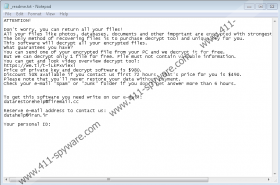Msop Ransomware Removal Guide
Msop Ransomware belongs to the Stop Ransomware family. Most of the file-encrypting threats from this family make files unusable and display ransom notes asking to pay for restoring data either $490 or $980 if a user does not make a payment in 72 hours. Of course, we advise against paying the ransom since you cannot know for sure that the hackers behind the malware will hold on to their end of the deal. If you are not confident that dealing with cybercriminals would be a good idea, we advise reading our full report first before deciding what to do with this malicious application. For anyone who may decide they want to erase Msop Ransomware from their systems, we can provide manual deletion instructions located below this article. On the other hand, if eliminating the malicious application on your own seems a bit too challenging, keep in mind that you can erase it with a reliable security tool instead.
Msop Ransomware might be spread via various unreliable websites. For example, victims could be made to believe that it is an update or a software installer. Unfortunately, in such a case, instead of getting a program or updating software, a user would initiate the threat’s installation. Currently, it is still popular to disguise malware installers as text documents or other harmless-looking files and send them to targeted victims or random users via email. Launching such data also ends with allowing threats to settle in. If you find it hard to separate harmless files from malicious files or suspicious data, we recommend employing a reliable antimalware tool that could identify potentially harmful files for you. All you would have to do is scan files received from unreliable websites or people you do not know with your chosen antimalware tool. After a scan, the tool ought to tell you if it is safe to open a file or if it is best to get rid of it.
The malicious application can enter a system without you noticing anything, and it might hide until it finishes encrypting your files. However, before starting the encryption process, Msop Ransomware should create files in the locations listed in our deletion instructions located below this report. Soon after, the threat ought to start encrypting all pictures, videos, archives, text files, and other files alike. Our specialists say that the malware ought to leave program data and files associated with the infected computer’s operating system. Meaning, it should only encrypt files considered to be personal since victims are more likely to put up with demands to get it back. Encrypted data should be marked with an extension called .msop, e.g., picture.jpg.msop.
When all targeted files get encrypted and marked with the mentioned extension, Msop Ransomware should show a ransom note. It ought to be a text document called _readme.txt. As said earlier, the hackers who created the malware ought to demand a considerable sum of money in exchange for tools that could decrypt the threat’s enciphered files. Sadly, you cannot know if hackers will provide what they promise. Once the ransom ends up in their account, they could do anything with it, whether they send the promised decryption tools or not. If you think they could scam you and do not want to take any chances, we advise against paying the ransom.
Users who find the discussed malicious application on their systems should not wait too long to get rid of it. Apparently, the malware might restart with the operating system, and so, it is possible that it may continue encrypting files it has not enciphered yet after every restart. To erase Msop Ransomware manually, you could use the deletion instructions located below, but if they seem too complicated, do not hesitate to employ a reliable antimalware tool instead.
Get rid of Msop Ransomware
- Tap Ctrl+Alt+Delete.
- Pick Task Manager.
- Select the Processes tab.
- Look for a process associated with the malware.
- Select the process and click End Task.
- Leave Task Manager.
- Tap Win+E.
- Go to these locations:
%TEMP%
%USERPROFILE%\Downloads
%USERPROFILE%\Desktop - Find the malicious file opened before the system got infected, right-click it, and select Delete.
- Search for files named _readme.txt and PersonalID.txt, right-click them, and select Delete.
- Check these locations:
%LOCALAPPDATA%
%USERPROFILE%\Local Settings\Application Data - Find the malware’s created folders with a random names, e.g., 0215171b-ba55-7xal-a49s-c2fk4162159c, right-click them, and choose Delete.
- Navigate to this location: %WINDIR%\System32\Tasks
- Find a task titled Time Trigger Task, right-click it, and select Delete.
- Close File Explorer.
- Tap Win+R.
- Type Regedit and click Enter.
- Go to: HKEY_CURRENT_USER\Software\Microsoft\Windows\CurrentVersion\Run
- Identify the malware’s created value name, e.g., SysHelper, right-click this value name, and press Delete.
- Close Registry Editor.
- Empty Recycle Bin.
- Restart the computer.
Msop Ransomware Screenshots:


